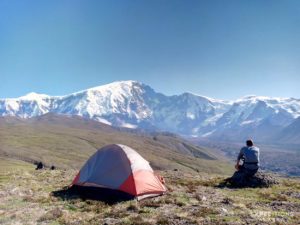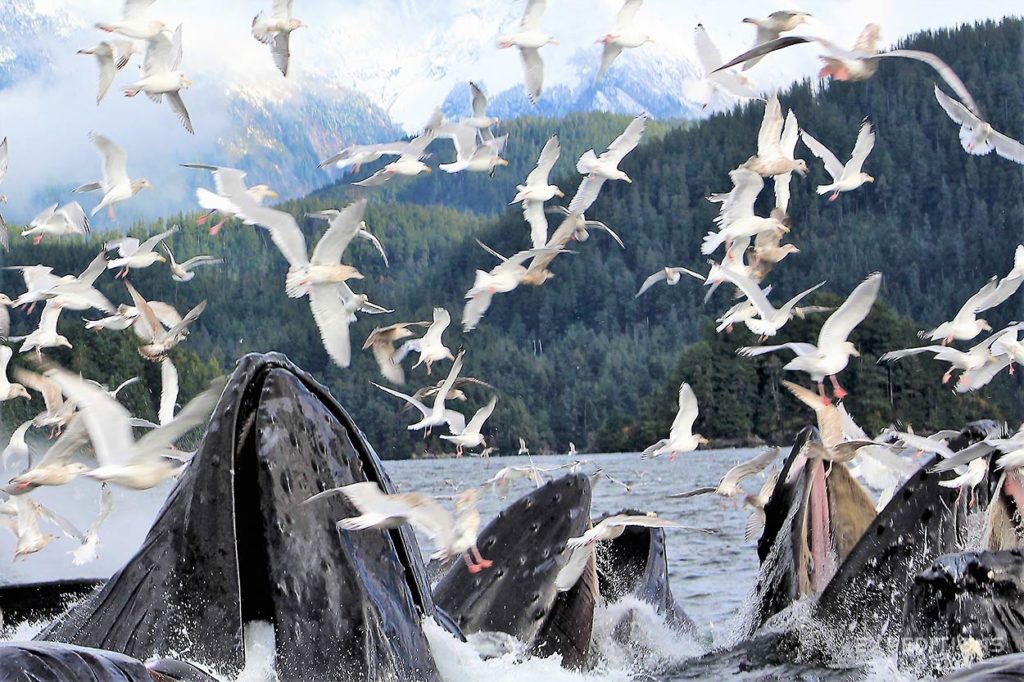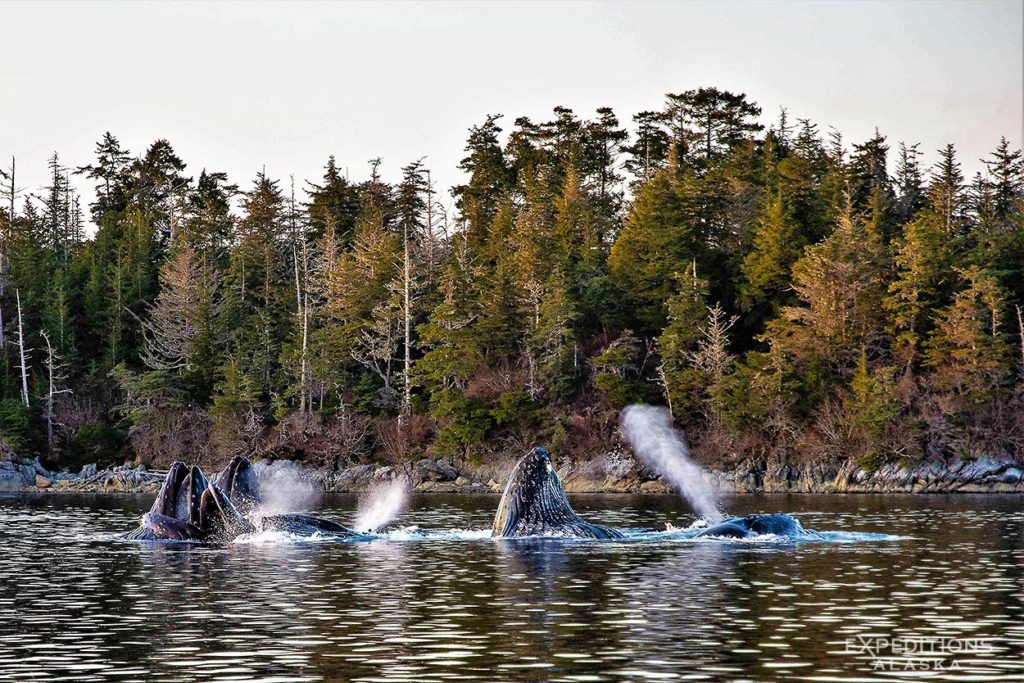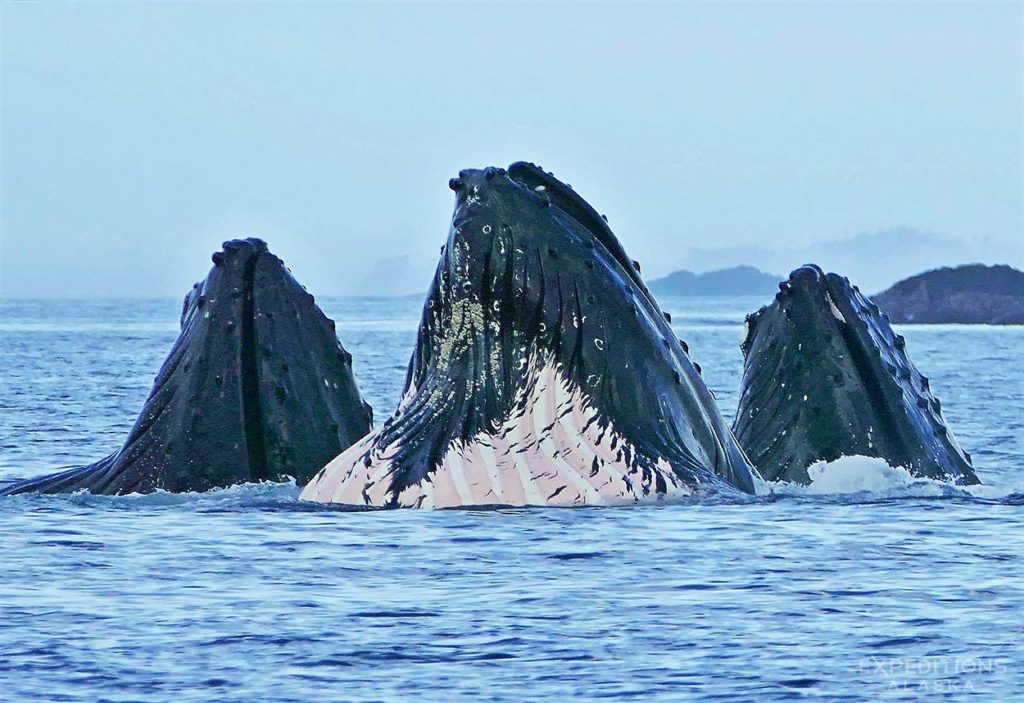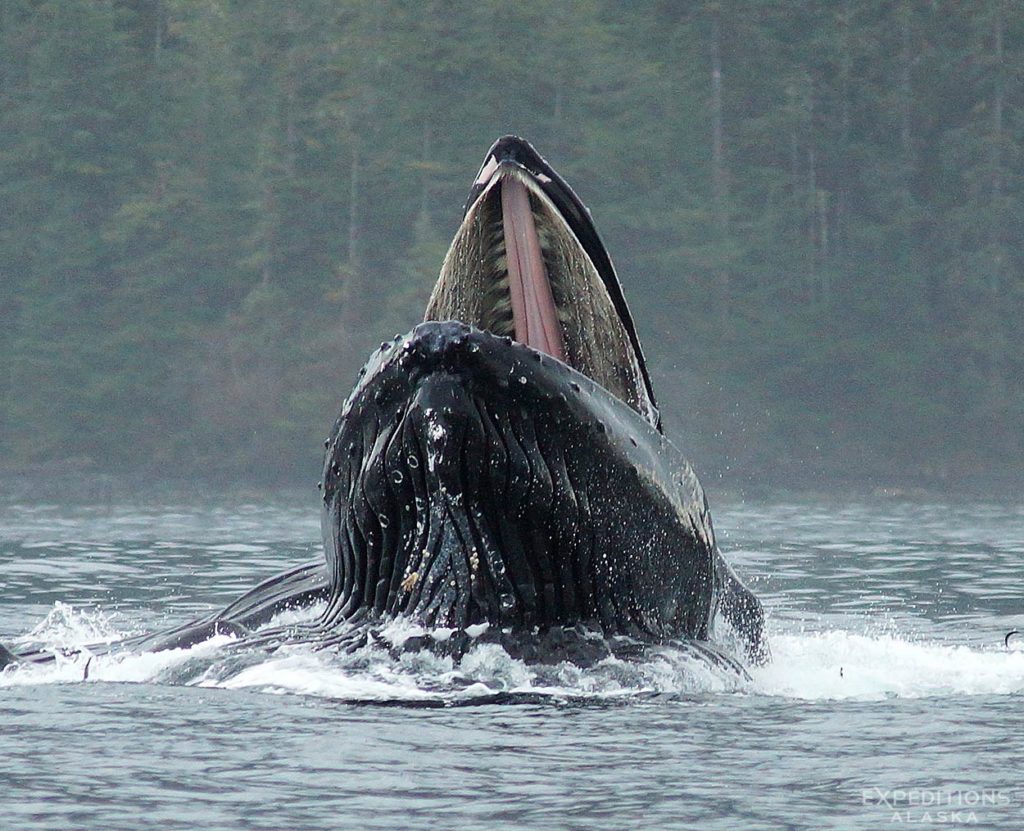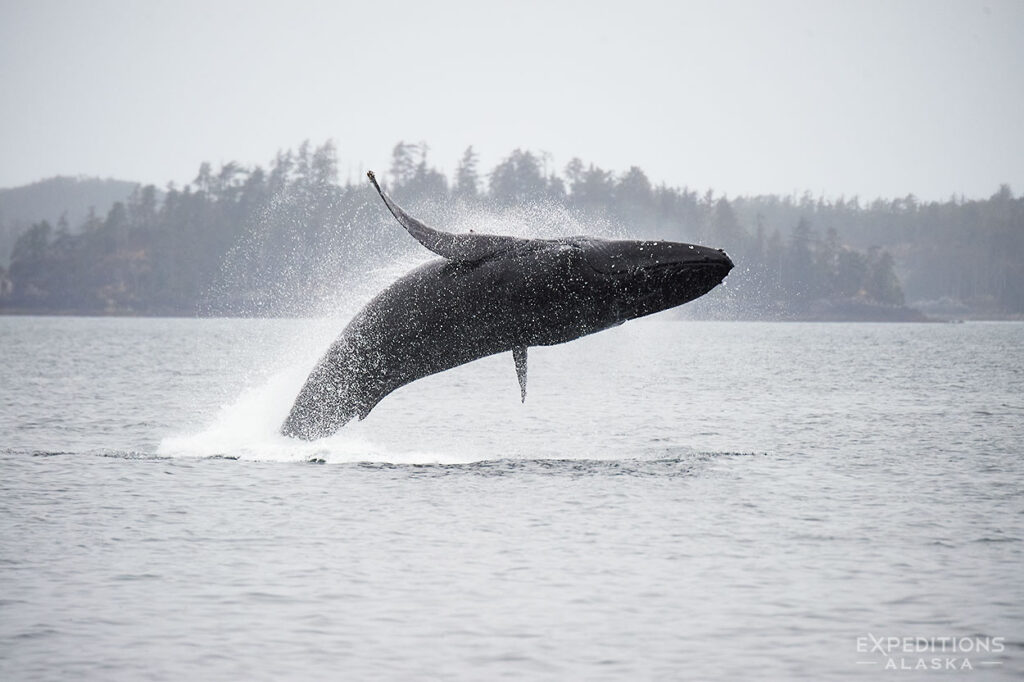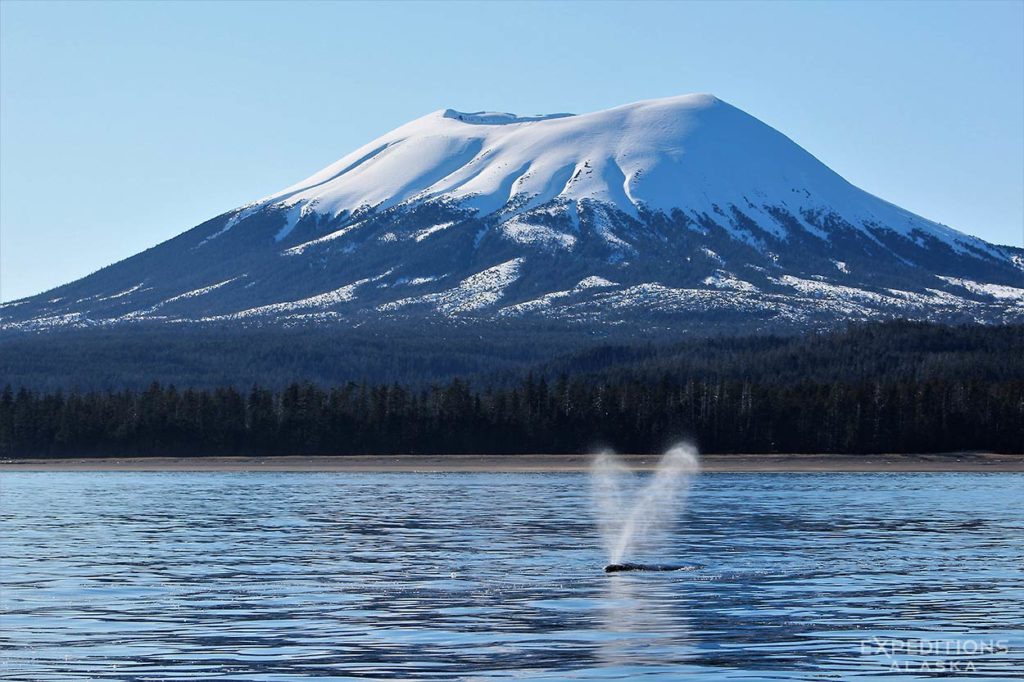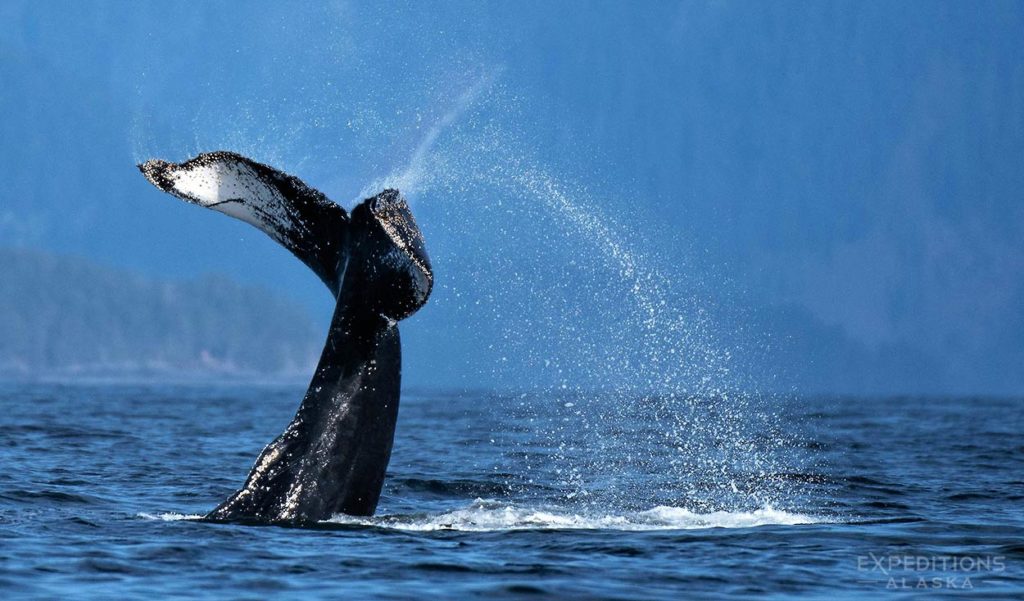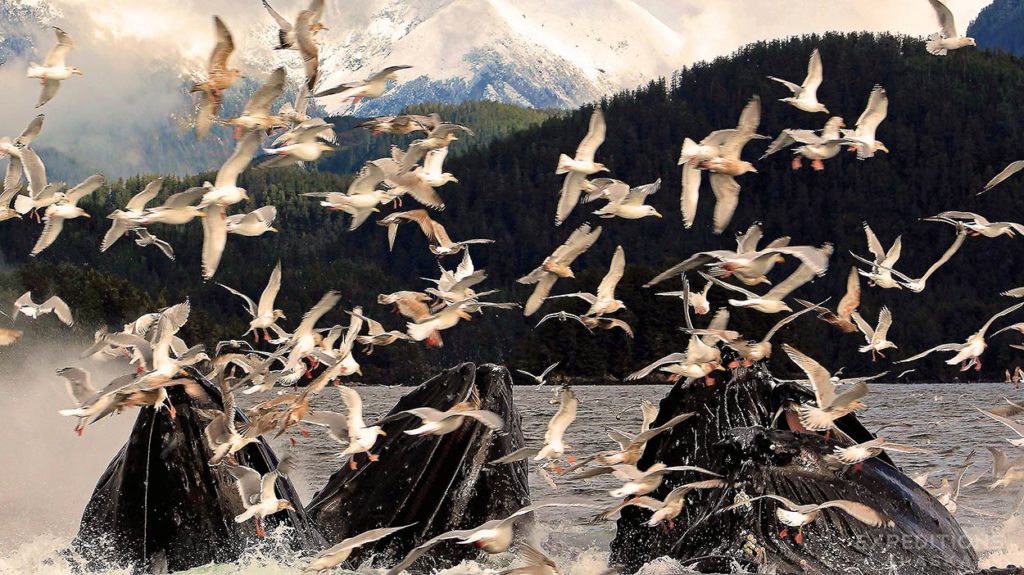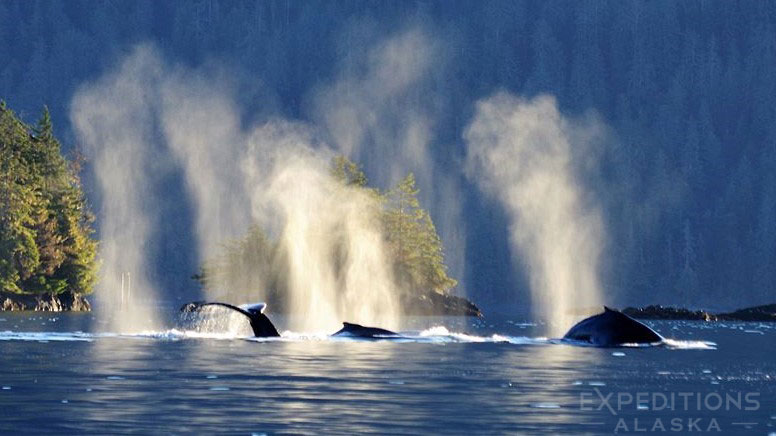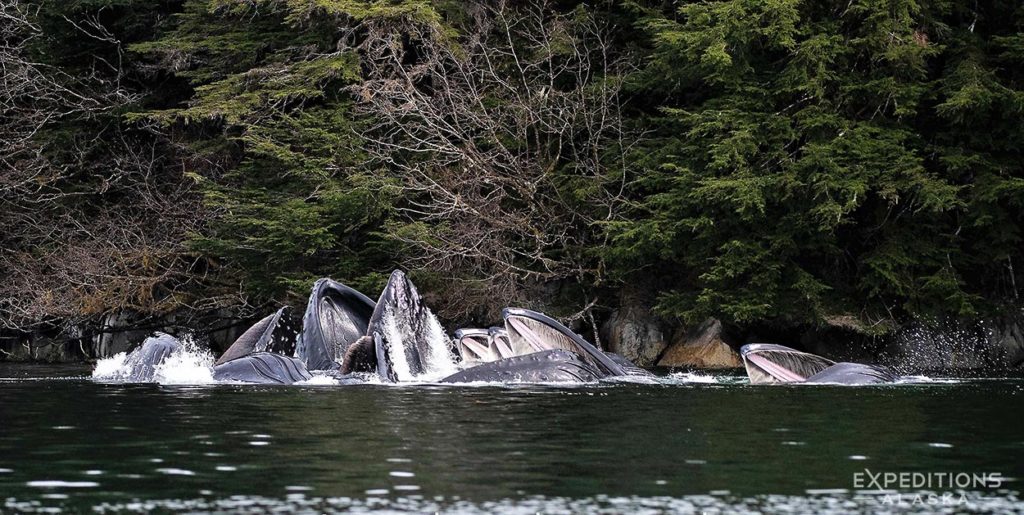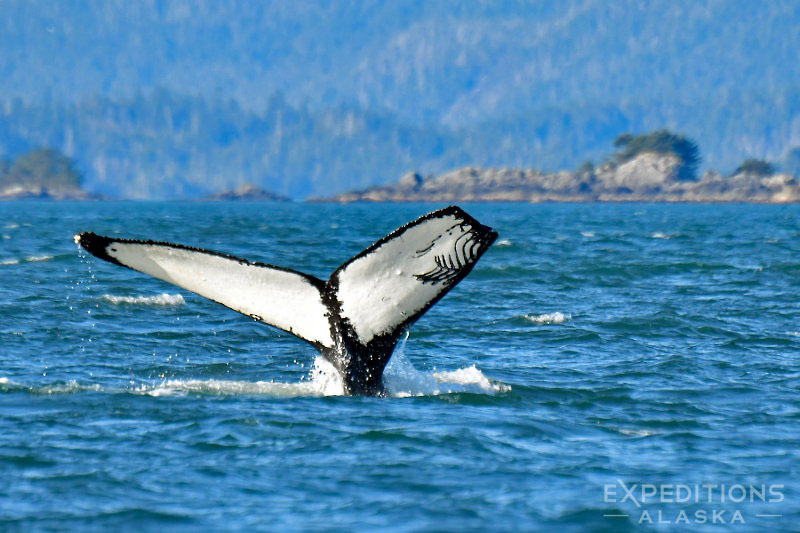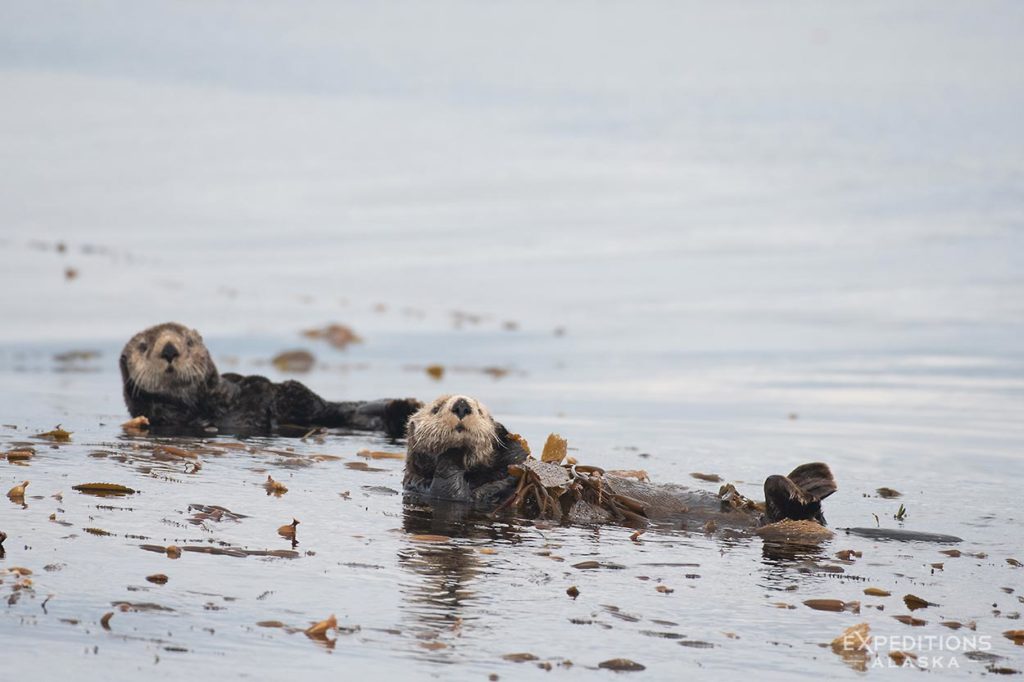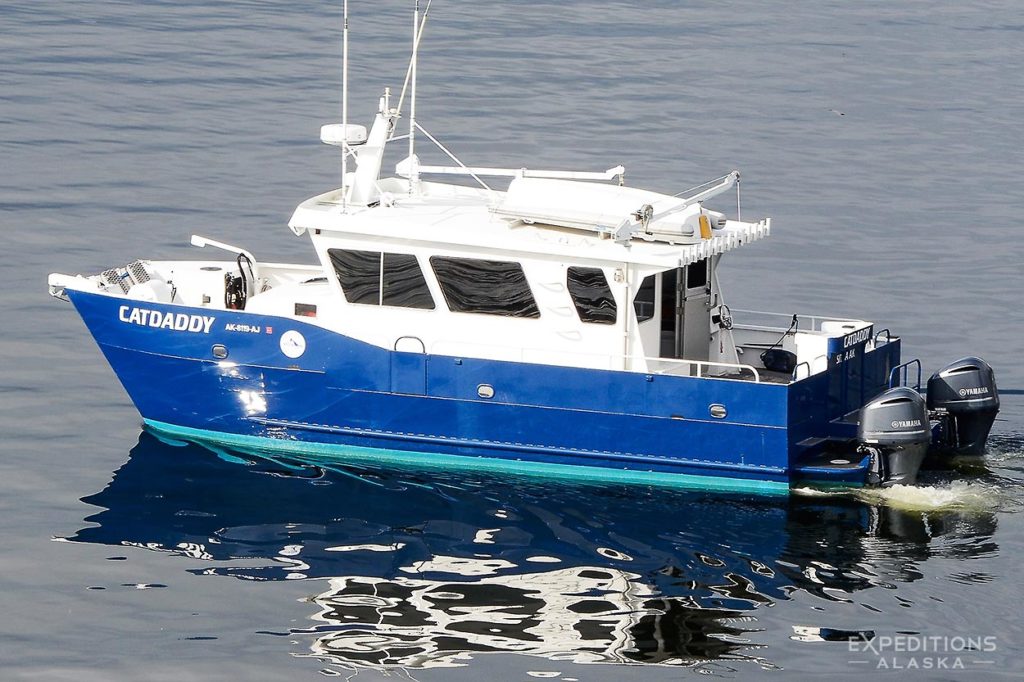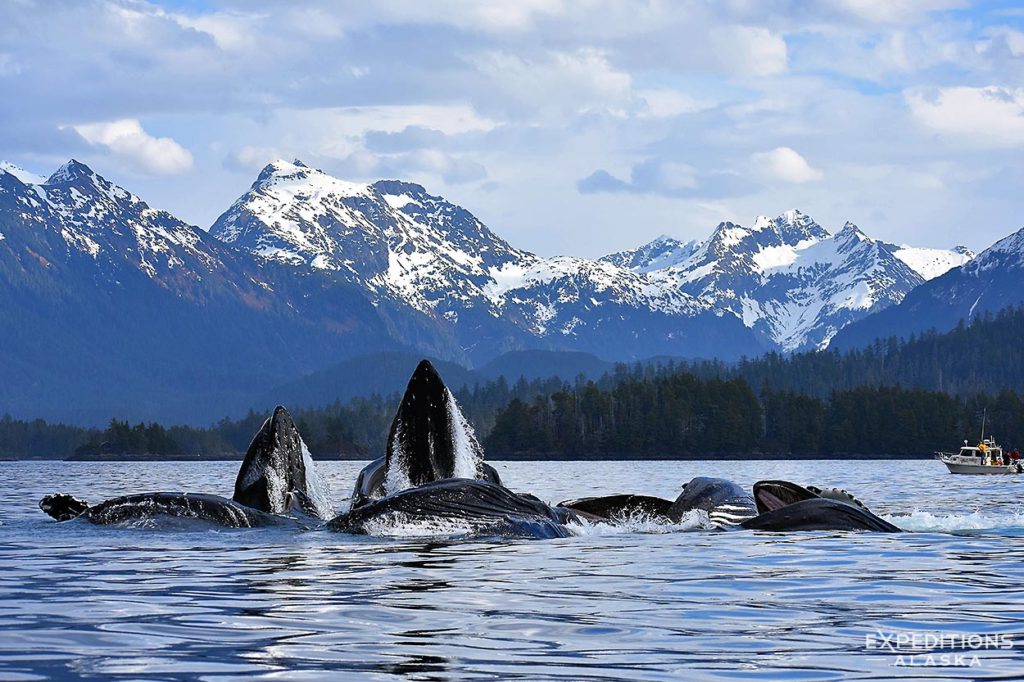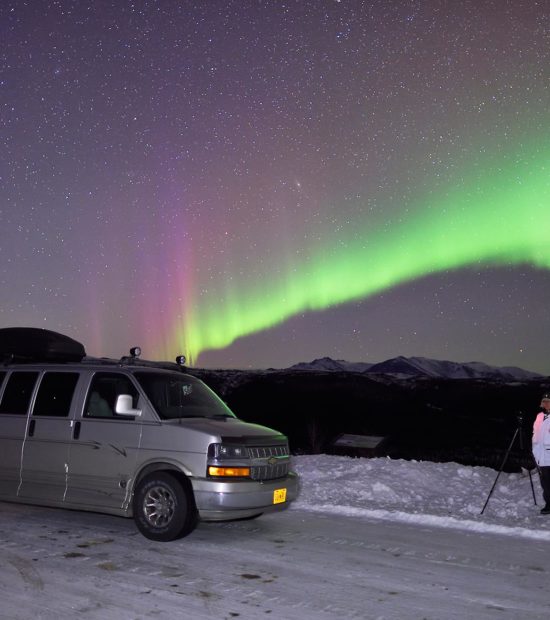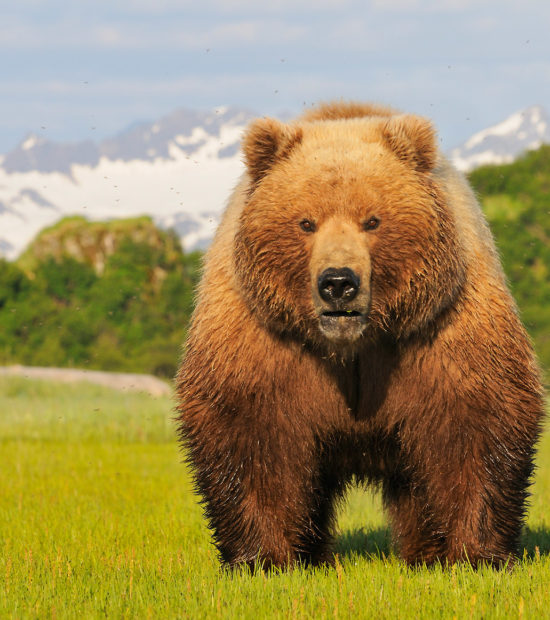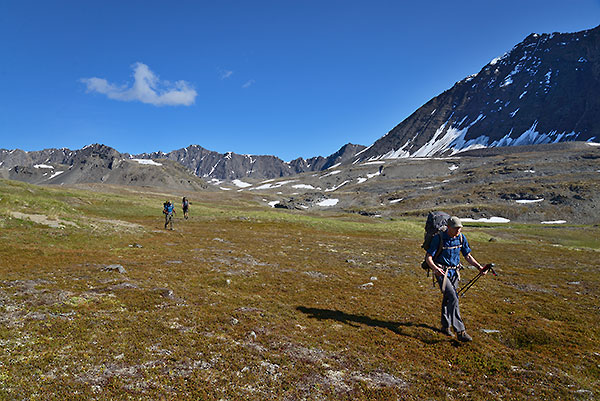Info
Other Critters
We only have the Bigg’s (Transient) Orca in our waters. We see them on about 10% of our trips. Some of the encounters we’ve had have been spectacular. However, I wouldn’t characterize them as likely to be seen. The chances increase during this time of the year because of the increase of prey, Harbor Seals, and Sealions.
We generally don’t see the Pacific White-Sided Dolphin, but we do see Harbor Porpoise frequently. Dall’s Porpoise are not common in the waters where bubble-net feeding occurs at this time of the year and are more likely to be observed in waters about two hours away from Sitka.
Bears are starting to emerge and come to the beaches. During our chosen dates the Gray whales have started to arrive in Sitka also. They seem to like feeding on the herring eggs that cover the kelp beds. Sea Otters are abundant, and this is also a time when we see moms with pups on their bellies
Birds
The seabirds we see here are; Mergansers, Pelagic and Double-Crested Cormorants, Buffleheads, Golden Eyes, Harlequin Ducks, Surf Scoters, Marbled Murrelets, Blue Herons, Long-Tailed Ducks, Horned Grebes, Rhinoceros Auklets, King Fishers, Black Oyster Catchers, Pigeon Guillemots, Common and Thick Billed Murres.
We see Tufted Puffins occasionally at this time of the year in their winter plumage. It’s not until May that they gather in large numbers on an island close to Sitka for nesting adorned in their colorful beak.
There are about 8 different species of Gulls in our area. Often, we are challenged to distinguish their species. Trumpeter Swans and several species of Geese are also fairly common during your visit.
Whale Numbers
Neil (our boat captain) has witnessed over fifty (50) Humpback whales assembled in several bubble-net feeding groups located in a five (5) square mile section of our waters during this time of the year.
It is common for guests on these expeditions to see bubble-net feeding thirty (30) times during a single eight 8-hour trip, and some are fortunate to have this scenario play out as frequently as seventy (70) times during that same interval.
Other Whale Antics
Bubble-Net feeding is not the only acrobatic humpback demonstration to which our guests get treated. They often capture Tail slapping, Flipper Slapping, Spy Hopping, Flick Feeding, and the spectacular breach.
The Backdrop
Our rugged snow-covered peaks of the Tongass National Forest, rocky kelp burdened islets, and the crimson-streaked dormant Mt Edgecumbe volcano provide an excellent background for photographing these awe-inspiring displays.
Lodging
We stay in a small hotel in Sitka. Yes you get you own rom, there is no additional charge for a single supplement or anything. Just let us know what your lodging requirements if traveling with a partner, friend, group, etc.
The Reason for the Season
Hundreds of thousands of tons of Herring congregate in the waters here to spawn in the early Spring. The humpbacks have learned to coordinate their return from the mating and calving grounds in Hawaii with the Herrings arrival. During the migration to, from, and while in Hawaii, Humpback whales do not feed. When they arrive in Sitka Sound, they are ready to gorge themselves on the calorie-rich Herring. For this reason, Whale researchers have dubbed the Sitka Sound as the humpbacks’ first service station.
There is a multitude of theories behind why humpback whales use bubble netting as a feeding method. The most popular idea is one of survival. After being hunted to near extinction, it is believed that humpback whales developed this method of feeding so as many whales as possible can feed in a short amount of time.
The Herring return attracts a host of other species such as Orcas, Stellar Sealions, Harbor Seals, man (to harvest herring eggs), and hundreds of eagles. We witness occasions where the only birds that came to feast on the Whale’s leftovers were the Bald Eagles. This truly is a time when mother nature awakens from her winter slumber and blossoms with a flourish.
Our Responsibility
Watching the graceful and athletic performances of these 40-plus ton beautiful creatures instinctually serves to remind and motivate all of us for the sustained need for conservation, education, and research to help protect the precious marine environment.
Our company, A Whale’s Song Expeditions, is proud to be recognized by the World Cetacean Alliance as a certified responsible whale-watching company. This is given to operators that meet the highest standards for customer experience, and their practices ensure that the animals they encounter are not put under excess stress or disturbance.
We believe our engagement goes beyond animal welfare and customer experience and should benefit local communities and positively affect the environment. That is why we integrate environmental, social, and economic sustainability into our business.
We also partner with the National Oceanic and Atmospheric Administration’s (NOAA) organization called Whale SENSE, promoting additional guidelines for watching whales above and beyond the Marine Mammal Protection Act. We also dedicate 5% of our profits to the following local non-profit organizations the Alaska Raptor Center & the Alaska Whale Foundation.
Where Are We
FAQs
-
What camera gear should I bring?
Something mobile and fast. A 70-200mm f2.8 is great. And as with all wildlife photography, I recommend a longer lens, but something hand-holdable is better. A 600mm f4 would be a bit cumbersome.
Bring a backup body if you can, plenty of batteries, and cards. We’ll be able to download images each night as well.
Bring a rain cover.
We’ll have a more detailed gear packing list before your trip.
-
What clothing do I need?
Warm and dry is good.
Anytime you’re on the water it can be chilly, and remember that even in southeast Alaska, April is more an end of winter than a start of spring.
I’ll bring a rubber rain jacket rather than a lighter weight, less reliable gore-tex jacket. Layers of good puffy insulation. Gloves and warm socks and a beanie.
If you have insulated rubber boots, they’ll work for footwear.
-
Tell me about Sitka
Photo opportunities in what is often voted as Alaska’s most beautiful town abound.
From the landscapes of craggy ice field covered mountain peaks to the ships and fishing vessels in Alaska’s most extensive harbor system, to the historical and cultural locations throughout Alaska’s first capital, to the weather-worn Russian cemeteries or the colorful tidepool life, you will indeed find many subjects in this town with seemingly endless photographic muses.
Sitka is located on Baranof Island, on the outer coast of Alaska’s Inside Passage.Like most Southeast Alaska communities, Sitka is accessible only by air, sea, or birth. The downtown area is centrally located, and most interest points are within walking distance of one another.
-
How do we get to Sitka?
Alaska Airlines has daily flights to Sitka’s Rocky Gutierrez Airport.
-
Whose photos are these?
Correct, as I haven’t been on this very much tour myself, these images, with the exception of the first image on the page of the Humpback whale breaching, are not mine but the property rights of our boat captain.
Photographer Kathy Lentz owns the large image closeup of the open mouhted whales.
-
What's Included/Not Included?
Photo Tours include the following.
* Professional Guide Service: Experience is paramount, as is a friendly, flexible atmosphere for your trip and I go out of my way to bring that to the all tours. Backcountry and wilderness travel in Alaska can be intimidating for a novice and even for some intermediate and experienced folks. A qualified guide service can go a long way to minimizing problems that may come up. Customers returning for
seveneightten consecutive hiking trips with Expeditions Alaska speaks volumes for the value of a good guide. What I offer.* Travel and Accommodations: This is trip dependent. Some trips are hotel based, others we camp, or charter a private boat for the trip. Accommodations are included on all trips. You’ll want to see the specific trip you’re considering to see necessary travel logistics and accommodation arrangements.
* Safety: Any professional guide service puts safety first. A fully qualified Wilderness First Aid certification, and a satellite available for emergency backcountry service if necessary and a backup messaging device as well.. This is an owner-operated business and all participants can feel confident knowing they’re not getting an intern or inexperienced guide for their trip.
* Instruction: I’ll be glad to offer any assistance I can with photography instruction in the field. Most of these tours are not sold as “photography workshops”, but we generally spend quite a bit of time working on how we can improve our photography.
Of course, is you have any questions, do feel free to ask.
WHAT’S NOT INCLUDED?
Expeditions Alaska do not provide the following, unless otherwise specified.
a) Meals.
b) Travel arrangements to Sitka from outside Alaska.
c) trip insurance.
d) guide gratuities.
e) personal gear, camera gear, etc. But if you need something, give me a holler and we’ll see if we can work that out.
-
What’s a Photo Tour?
These photo tours are a flexible itinerary designed to assist the serious photographer put together a productive photography adventure. It means the trip is scheduled around your photography. We follow the light, getting out early to shoot dawn and getting out late to shoot dusk.
The long days of Alaska, for example, might mean alpenglow is at 11:30pm, and again at 4:30am. There’s simply no way to catch both of those times and still have a regular breakfast, lunch and dinner schedule and hike an 8 hour day. Well, there IS, but doing that for a week straight is an arduous task. So I run these tours around photography time, which means we might be catching up on rest, etc, during the middle of the day, so we can be where we need to be in the golden light of the evening.
Everything is tailored around photography, whether it’s a bear photo tour, a wildlife tour, a landscape photo tour to Skolai Pass or the Aurora borealis in the dark of winter. We shoot when the shooting is best, and we eat, sleep and hike outside of those hours. You don’t want to miss that golden brown bear photo because you’re back at the lodge having dinner!
-
What makes Expeditions Alaska Photo Tours so special?
I’m a guide. I guide trips for a living. I guide and lead trips for a living with nearly 15 years experience running my own guiding business. I’m a photo tour leader, not simply a photographer. Those are 2 very different things and my experience guiding and trip leadership set what I do apart from many of the other photo tour operators.
— I live here in Alaska. I think one of the most important facets in putting together a photo tour is not simply how well you plan things out but how well you’re able to respond to what you didn’t plan out. In other words what resources do you have available for your plan B, C & D when plan A fails. And as nature photographers we all know how easy it is for plan A to fall by the wayside. The resources here in Alaska available to me to accommodate changing plans, unforeseen circumstances, inclement weather, etc are vastly greater than someone who arrives in Alaska from Florida the day before your tour begins.
— I have my Alaska State Business Licence, insurance and all necessary Park Service Permits, etc. Be aware that in order for ANY business to operate inside Alaska an Alaska state business license is required. Most operators from outside Alaska who lead tours here don’t maintain a current business license from the State of Alaska or permits from the relevant land management agency (such as Commercial Use Permits from the National Park Service). This will inevitably lead to issues. This might not be a big deal to you but it will be to the insurance company you call should anything go awry on your trip.
— I’m a Wilderness First Responder. A lot of times in the field here in Alaska you’ll be photographing far from any immediate assistance. If it were me heading out into the field on remote location, I’d want to have some information on what level of first aid assistance is provided and readily accessible. Look at a map and see for yourself how remote a place like Katmai or Lake Clark is.
— Smaller groups. I keep group size limited to 5 photographers and I think that really makes a big difference to how productive the shoot might be. I see some other bear photo tours out there with 8-10 and even more people all trying to shoot together and getting in each other’s way. Inevitably some people miss out simply because there are too many people all vying for that one special angle or perspective.
— Environmental concern. I don’t know of a single other photo tour operation that has put both their money and time into conservation of the subjects we shoot here in Alaska. I’m currently organizing a photography contribution, for example, to oppose the development of the proposed Pebble Mine near Katmai and Lake Clark National Parks. Pebble Mine is an extractive development project which presents an immeasurable threat to the bears we all so love to photograph.
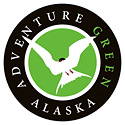
— I’ve also just had my business certified by Adventure Green Alaska Gold Level Standard (one of only 10 businesses statewide in Alaska to qualify) in environmentally friendly and sustainable travel. Expeditions Alaska is also a member of Sustainable Travel International, and contributor to many of Alaska’s most important environmental organizations. For more information read the Treat Lightly – Our Planet page.
— Location, location, location. I wouldn’t keep returning to these places if I thought I needed to go elsewhere to make good bear photos. I’ve put a lot of time into finding locations that work for photo tours.
— Experience shooting this subject. I’ve been visiting many of the same locations in Alaska for nearly 15 years now. For example, shooting the same grizzly bears, year in and year out. I photographed those bears for over 10 years before I ever led a photo tour there. I know both the location and the subject extremely well. I see a lot of tour operators coming to Alaska who have spent hardly any time at all shooting these bears, in these locations, a year or 2 at most. In some cases, not even that. If you’re looking at other bear tour operators be sure to ask when was the first time they ever headed over to the Alaska peninsula and photographed these brown bears.
— Isolation. Part of the joy of nature photography is being out in nature. Many of the trips we run we’re not staying at a lodge surrounded by a dozen other guests and tour operators and other lodges around the corner doing the same thing.
-
What clothing do I need?
This will depend on which trip you come out on. The clothing you want for the northern lights tour and the clothing you want for the coastal brown bears tour are 2 entirely beasts. Clothing for Winter Photography would be a starter for the Northern Lights tour.
As a basic standard though, you want to be warm, dry and comfortable. For most tours we do, you want some rain gear.
For the Fat Bears in the Fall Photo tour you do need waders.
Conversely, Bears of Summer, Grizzlies in the Mist and the Coastal Brown Bears tours you definitely want a pair of chest waders.
If you are interested in a particular trip give me a call or drop me an email and I’ll be glad to forward you with some more information specific to the trip you’re considering.
Like your camera gear, this subject is largely contextual. You want to be comfortable and don’t skimp on your gear.
Practice with your camera equipment before heading out on a trip. You don’t want to fly thousands of miles and spend thousands of dollars for that one chance to shoot a grizzly flying through the water and miss it because you weren’t sure how to adjust your camera/tripod/waders/shoelaces/etc. 🙂
For the Alaska Landscapes tour to Skolai Pass, see My Backpacking Gear.
-
Cancellation policy
Reserving your place on a trip requires a 50% deposit. Deposits are non-refundable. All trips be paid in full 45 days prior to the scheduled departure date.
If the client cancels on a trip paid in full, 80% of the price can be deferred and applied to another trip that is scheduled to occur within the next 12 months, provided that all three of the following occurs:
i) Expeditions Alaska, LLC is able to fill the cancelled spot,
ii) Expeditions Alaska LLC is able to fill the the trip that the client cancelled on, and
iii) 30 days (or more) notice is given.If a client cancels a trip and Expeditions Alaska is not able to completely fill that trip, regardless of the number of original participants in that trip, Expeditions Alaska will not defer or refund any portion of the cancelling client’s payment.
Expeditions Alaska, LLC cannot guarantee that a spot will be available on a scheduled trip in the next 12 months. If no spot is available and you cannot use your deposit in those 12 months, the deposit is forfeited and non-refundable.
If cancellation is within 30 days of the trip, only 50% of the fee can be carried over to a future trip. The remainder is forfeited and non-refundable.
No refunds, credit, or other reimbursements are given for cancellations within 14 days of the trip departure.
Expeditions Alaska, LLC reserves the right to cancel and/or modify the itinerary of a trip for any reason. If Expeditions Alaska cancels a trip you will be refunded your payment in full, minus a $250 administrative fees plus any unrecoverable deposits Expeditions Alaska, LLC made to organize the trip. If Expeditions Alaska cancels changes the date of a trip and you can no longer attend, you will be refunded your payment, minus a $250 administrative fees plus any unrecoverable deposits Expeditions Alaska, LLC made to organize the trip.
If weather or other factors delay or impede your trip, there will be no refund of fees. Expeditions Alaska, LLC is not responsible for any other costs incurred by the client as a result of the cancellation, delay, or modification of a trip.
Additional costs incurred through weather delays and itinerary changes are the responsibility of the client.
Additional costs incurred by the client, such as changes to flights or additional costs, etc, are the sole responsibility of the client.
* May be Trip dependent. See trip details on each page regarding the terms for the photo tour you are interested in.
-
I have more questions
I know you do. As well you should.
I recommend starting with the General Trip FAQ page
More questions? Email me or call me if you like.
Upon your reservation I’ll send out a comprehensive trip information packet that covers just about everything and more you might imagine about your trip.
Bubble-net feeding
Bubble-net feeding takes advantage of the congregation of the prey, herring in this case, as they school together in massive numbers for their spawning season. The humpback whales will dive deeply, blowing bubbles as they circle around beneath their prey.
The bubbles create a kind of corral into which the fish are hemmed. Humpback whales will also make a loud high-pitched noise that seems to heighten the frezy of the fish that appears to assist their hunt.
The humpback whales swim in ever-shrinking circles as they rise surface-ward, trapping the fish above.
Mouths agape, the humpback whales tear u and out of the water, gaping cavernous mouths catching up massive numbers of herring at a time.
It’s a feast for the ages.
Also called lunge feeding or bubble feeding, bubble-net feeding is an almost exclusively humpback whale behavior that works in certain circumstances for these massive creatures to consume the infinitely large numbers of calories they require to survive.
Humpback whales typically feed well below the surface. But this lunge feeding or bubble-net feeding is unusual in that it becomes a surface feeding behavior.
Another aspect of bubble-net feeding that is unusual is that humpback whales feed in large groups. Typically humpbacks feed individually. This cooperative behavior can be remarkably successful and is spectacular to watch.
The whales use vocalizations to coordinate and efficiently execute this method, and this way all of a group gets to feed.
It’s also a learned behavior, not something instinctual. Not all humpbacks or humpback whale groups engage in bubble-net feeding.
Photo Tour Logistics
As a simple outline here, you’ll need to make your way to Sitka, AK, and arrive no later than the day before our trip starts.
We’ll meet the night before, grab a meal and chat about the plan.
Morning of day 1 we head out with the boat captain and look for whales. Most days we do 4-hour stints on the water. Weather and other factors obviously can mitigate that so we’ll need to be flexible for alternatives.
Each day this is the plan, back to town for the evening and dinner and download images.
We’ll have lodging booked for your final night and you want to make your travel plans for the day after, or later.
As always, we can discuss specifics and alternatives if you need to.

